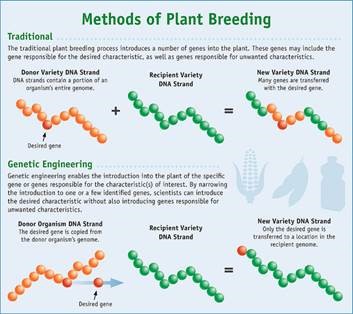Question
Answer
Expert response from Community Manager
Moderator for GMOAnswers.com
Friday, 26/06/2015 13:25
Kevin Folta, professor and chairman of the horticultural sciences at the University of Florida, wrote a very detailed response to a similar question outlining the different ways humans have modified plants beginning 10 to 20 thousand years ago. Read his full explanation here. An excerpt from this response pertaining to genetic modification, or genetic engineering, explains:
“The process of genetic engineering is a more precise method of genetic modification. Only one gene, or maybe a few genes, are needed to achieve the desired trait and are transferred from one organism to another. The difference between traditional breeding and genetic engineering is illustrated in the picture below, from the U.S. Food and Drug Administration. In popular culture, genetic engineering has become synonymous with genetic modification, and an organism that has been genetically engineered is often referred to as a genetically modified organism, or GMO. The technical term is ‘transgenic.’
“For more than 40 years, scientists have been able to cut DNA and paste it into a new context. Transgenic plants rely on scientists identifying and amplifying the gene of interest and then inserting it into Agrobacterium, a bacterial species that makes natural genetic exchanges with plants. Scientists have disarmed Agrobacterium to work for them. The lab strains of Agrobacterium (usually referred to as simply “Agro”) can deposit DNA into a plant cell. Scientists place the gene of interest into Agro and incubate it with plant tissues. Agro places the DNA into one cell, and then it is integrated into the genome. The one cell can be placed into media where it will divide into a clump called a callus, a blob of generic cells.
“Plant cells make decisions based on plant hormones. Placing a callus on various hormone combinations causes the callus to produce organized cellular structures that eventually emerge as new organs or embryos that later emerge into a whole plant. If that foundational cell has your gene in it, it will be present in every cell of the new plant.
“This is the process in a short form. In any lab, it is reasonably simple for most species. Today, most labs don’t even bother. Instead, they contract the work out to one of several companies or university services that make the transgenic for you. Basically, you can get your favorite gene installed in most ag crops pretty easily. From there, the gene might instruct the plant to do something it never did, produce more of a product that is naturally there or even turn a gene off. All of these are valuable outcomes of the process.”

To learn more about how GMOs are created, check out our “Explore the Basics” section. You might also be interested in viewing this video, which describes the development of the GM Hawaiian papaya.
Answer
Expert response from Community Manager
Moderator for GMOAnswers.com
Friday, 26/06/2015 13:25
Kevin Folta, professor and chairman of the horticultural sciences at the University of Florida, wrote a very detailed response to a similar question outlining the different ways humans have modified plants beginning 10 to 20 thousand years ago. Read his full explanation here. An excerpt from this response pertaining to genetic modification, or genetic engineering, explains:
“The process of genetic engineering is a more precise method of genetic modification. Only one gene, or maybe a few genes, are needed to achieve the desired trait and are transferred from one organism to another. The difference between traditional breeding and genetic engineering is illustrated in the picture below, from the U.S. Food and Drug Administration. In popular culture, genetic engineering has become synonymous with genetic modification, and an organism that has been genetically engineered is often referred to as a genetically modified organism, or GMO. The technical term is ‘transgenic.’
“For more than 40 years, scientists have been able to cut DNA and paste it into a new context. Transgenic plants rely on scientists identifying and amplifying the gene of interest and then inserting it into Agrobacterium, a bacterial species that makes natural genetic exchanges with plants. Scientists have disarmed Agrobacterium to work for them. The lab strains of Agrobacterium (usually referred to as simply “Agro”) can deposit DNA into a plant cell. Scientists place the gene of interest into Agro and incubate it with plant tissues. Agro places the DNA into one cell, and then it is integrated into the genome. The one cell can be placed into media where it will divide into a clump called a callus, a blob of generic cells.
“Plant cells make decisions based on plant hormones. Placing a callus on various hormone combinations causes the callus to produce organized cellular structures that eventually emerge as new organs or embryos that later emerge into a whole plant. If that foundational cell has your gene in it, it will be present in every cell of the new plant.
“This is the process in a short form. In any lab, it is reasonably simple for most species. Today, most labs don’t even bother. Instead, they contract the work out to one of several companies or university services that make the transgenic for you. Basically, you can get your favorite gene installed in most ag crops pretty easily. From there, the gene might instruct the plant to do something it never did, produce more of a product that is naturally there or even turn a gene off. All of these are valuable outcomes of the process.”

To learn more about how GMOs are created, check out our “Explore the Basics” section. You might also be interested in viewing this video, which describes the development of the GM Hawaiian papaya.
GMO Innovation Contest Recap!
